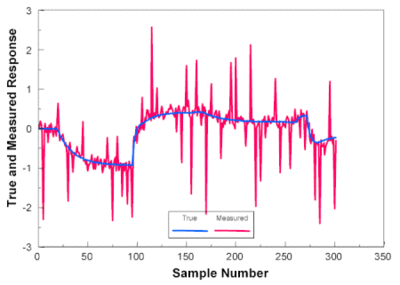Difference between revisions of "Electromagnetic interference"
| [checked revision] | [checked revision] |
| Line 1: | Line 1: | ||
| − | [[File:noise1.gif|thumb|EMI coupled to a clean signal (blue) can result in noisy signal (red)]] | + | [[File:noise1.gif|thumb|EMI coupled to a clean signal (blue) can result in noisy signal (red). If this was for example torque [[setpoint signal]], then motor would exhibit torque noise and hissing sound.]] |
Electromagnetic interference a.k.a. '''EMI''' (also called radio-frequency interference or '''RFI''') is disturbance that affects an electrical circuit due to either electromagnetic induction or electromagnetic radiation emitted from an external source. The disturbance may interrupt, obstruct, or otherwise degrade or limit the effective performance of the circuit. These effects can range from a simple degradation of data to a total loss of data.[2] The source may be any object, artificial or natural, that carries rapidly changing electrical currents, such as an electrical circuit, the Sun or the Northern Lights. [http://en.wikipedia.org/wiki/Electromagnetic_interference] | Electromagnetic interference a.k.a. '''EMI''' (also called radio-frequency interference or '''RFI''') is disturbance that affects an electrical circuit due to either electromagnetic induction or electromagnetic radiation emitted from an external source. The disturbance may interrupt, obstruct, or otherwise degrade or limit the effective performance of the circuit. These effects can range from a simple degradation of data to a total loss of data.[2] The source may be any object, artificial or natural, that carries rapidly changing electrical currents, such as an electrical circuit, the Sun or the Northern Lights. [http://en.wikipedia.org/wiki/Electromagnetic_interference] | ||
Revision as of 18:23, 6 August 2013

Electromagnetic interference a.k.a. EMI (also called radio-frequency interference or RFI) is disturbance that affects an electrical circuit due to either electromagnetic induction or electromagnetic radiation emitted from an external source. The disturbance may interrupt, obstruct, or otherwise degrade or limit the effective performance of the circuit. These effects can range from a simple degradation of data to a total loss of data.[2] The source may be any object, artificial or natural, that carries rapidly changing electrical currents, such as an electrical circuit, the Sun or the Northern Lights. [1]
See more at Wikipedia: http://en.wikipedia.org/wiki/Electromagnetic_interference
Coupling methods
Most common methods of EMI transfer from source to victim are:
- Radiation as electromagnetic radiation
- Magnetic coupling
- Capacitive coupling
- Common-mode impedance coupling
Capacitive coupling in motor control
In motor control applications capacitive coupling is the most common cause for EMI problems. Capacitive coupling occurs when unshielded conductors are in each other's proximity and source conductor is carrying voltage signal with high slew rate (dv/dt). Example of such source is the motor leads carrying high voltage PWM signal.
The most effective methods of suppressing this noise are:
- Use shielded conductor and tie cable shield to stable voltage potential such as earth. Cable shield provides Faraday's cage that attenuates the radiating electric field of internal conductors.
- Use EMI suppression cores near the EMI source. For best efficiency, run only interfering signals through core and leave cable shield and possible earth conductor outside the core.
See more at: http://www.electrical-installation.org/enwiki/Capacitive_coupling